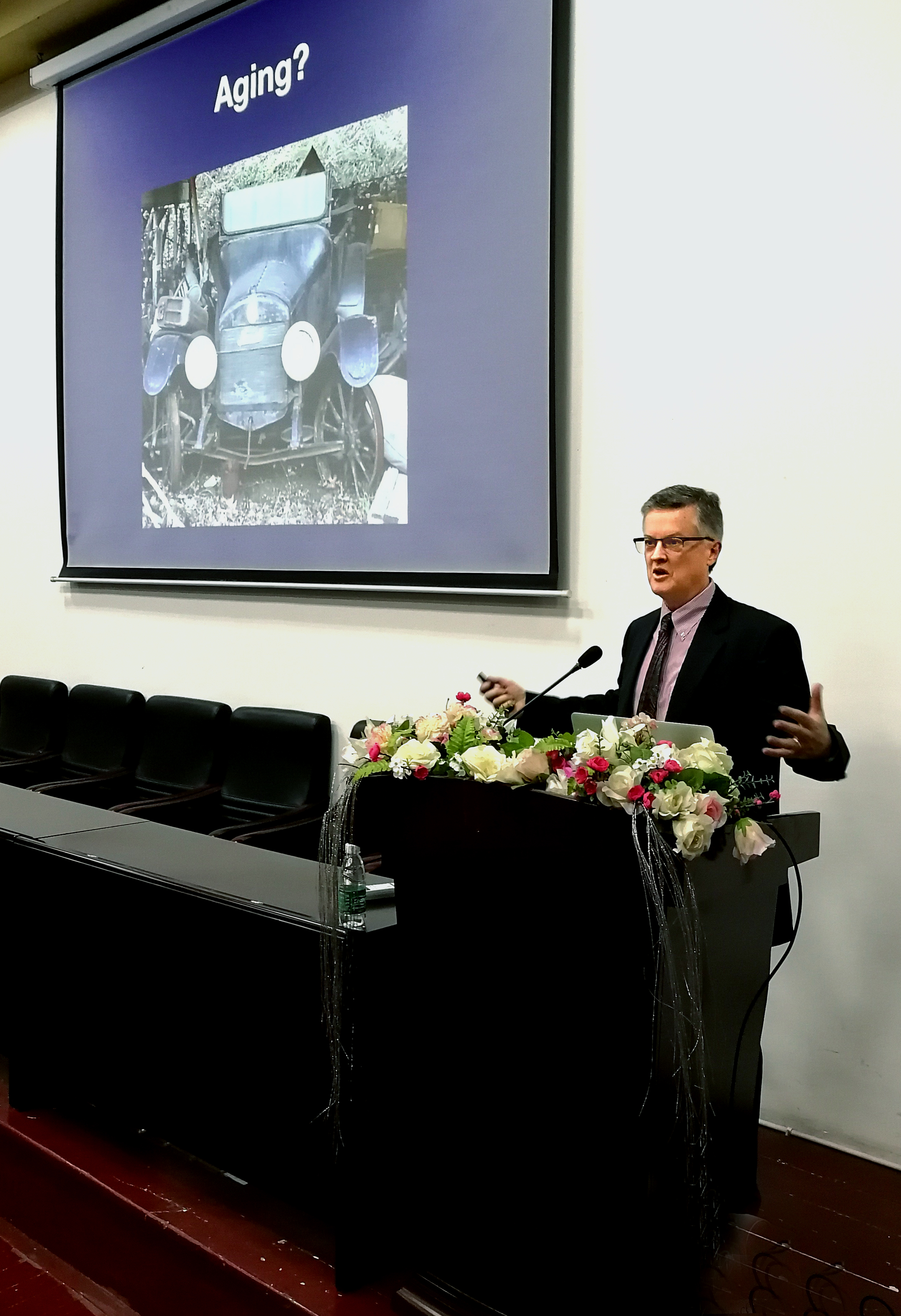Thomas Keith Blackwell, Professor of Harvard Medical School gave a wonderful academic seminar in Lecture Hall of the 5thteaching building On the morning of October 27, 2017. Our department heads, teachers and students of our college attended the lecture, the report was chaired by Prof. Xiaodong Sun, from Department of Pharmacology.
In this report, Professor Blackwell focused on the research on nematodes, explored the stress-defense mechanism of cells on environmental and metabolic stress and their significance in anti-aging and longevity promotion, and described the mechanisms known to promote longevity and anti-aging, including stress defense mechanisms for oxides and exogenous compounds, maintenance of proteasome and intracellular protein balance, cell self-enhancement, increased regenerative capacity, and so on.

Prof. Blackwell on the Lecture
Professor Blackwell's report is divided into two parts. The first part mainly focuses on the specific mechanisms by which reactive oxygen species regulate SKN-1 / Nrf2 protein and activate downstream stress defense pathways and anti-aging. In his report, he said the regulatory pathway is highly conserved. SKN-1 is a homologue of Nrf1,2,3 in higher animals, which is a necessary gene for dietary restriction, protein synthesis reduction, insulin pathway, and reduction of mTOR pathway and other mechanisms that promote the lifespan and anti-aging of C. elegans.
Lecture Scene
In the second part, Professor Blackwell mainly discussed the specific mechanism of SKN-1a / Nrf1 protein regulating proteasome expression to maintain intracellular protein balance and anti-aging. He introduced the use of bortezomib, a proteasome inhibitor, for the treatment of myeloma drugs and pointed out that when proteasome downregulates Nrf-1 into the nucleus to increase the compensatory expression of the proteasome, thus showing resistance to bortezomib. However, large-scale genomic RNAi screening revealed that phosphorylation of Nrf1 by MPK-1 / ERK is necessary for its nuclear entry, while the ERK inhibitor can prevent nuclear entry of Nrf1 and proteasome compensatory expression, thereby enhancing the killing effect of bortezomib on myeloma cells. Therefore, the study also revealed the potential value of its treatment of tumors.
After the lecture, students and teachers enthusiastically asked questions, Prof. Blackwell interacted positively with them, sharing academic viewpoints, and on-site atmosphere was extremely active.
The lecture aroused the great interest of the students and teachers, and also provided new ideas and methods for research and exploration while broadening our academic horizons.
Thomas Keith Blackwell is professor of genetics at Harvard Medical School and senior fellow at the Gascin Diabetes Center. He was the editorial board member of Aging Cell magazine and invited reviewer of a number of top international academic journals (Cell, Nature, Science, Cell Metabolism, Molecular Cell, etc.). Professor Blackwell is devoted to exploring mechanisms of aging and promoting longevity, as well as illustrating how cells and tissues protect against environmental stress and metabolic stress. As first author or correspondent, he has published many high-level papers in leading international journals, including Cell, Nature, Science, Mol Cell, Cell Metab and PNAS.
CV of Professor Keith Blackwell:
Keith Blackwell, MD, PhDJoslin Diabetes Center
Harvard Medical School Department of Genetics
He received a B.S. in Chemistry from Duke University in 1978, then entered the Medical Scientist Training Program at Columbia University. He graduated from Columbia with an M.D. in 1987, and a Ph.D. in Microbiology in 1988. He did his thesis work with Dr. Frederick Alt, working on the mechanism and regulation of immunoglobulin gene assembly. Upon graduating from medical school he decided to pursue a research career full time, and rejoined the Alt lab until 1989, when he began a postdoctoral fellowship with the late Dr. Harold Weintraub at the Fred Hutchinson Cancer Research Center in Seattle. Here he studied functions and DNA recognition properties of basic-helix-loop-helix protein transcription factors. He started his own lab at the CBR Institute and Harvard Medical School in 1993. At the beginning of 2004 he moved to Joslin Diabetes Center, as a Senior Investigator and Head of the Section on Developmental and Stem Cell Biology. He is now Associate Research Director there and a Professor of Genetics at Harvard Medical School. He became interested in the C. elegans system initially as a postdoctoral fellow, when he collaborated with Jim Priess to investigate whether the developmental regulator SKN-1 functions as a transcription factor. This interest led him later to begin working with C. elegans in his own laboratory, so that now essentially all of his lab’s projects involve this model organism. His work on C. elegans oogenesis, early embryonic development, and relationships between stress and stem cell function led them into the stem cell field.